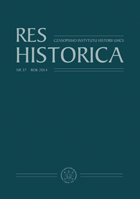Złodzieje w międzywojennym Lublinie. Analiza historyczno-kryminologiczna
Thieves in Interwar Lublin. Historical and Criminological Analysis
Author(s): Mateusz RodakSubject(s): Criminal Law, Social history, Interwar Period (1920 - 1939)
Published by: Wydawnictwo Naukowe Uniwersytetu Marii Curie-Sklodowskiej
Keywords: crime; Lublin; Second Polish Republic; GIS; criminology; thieves; poverty; exclusion;
Summary/Abstract: The article, the subject of which places it in the fi eld of Urban Studies, is an att empt to present a multi-faceted characterization of the community of thieves in Lublin in the interwar period. For this purpose, methods of statistical and criminological analysis and GIS technology were used. First, the estimated size of the study group was determined. When reconstructing its characteristics, the infl uence of various variables (mainly sex and religion of the perpetrators of the theft) was taken into account. An initial description of the socio-professional structure of the environment was made. Thanks to the use of GIS technology, the local structure of the thieves’ place of residence and theft was reconstructed. By taking into account various variables, the patt ern of criminal behaviour functioning in interwar Lublin was described. At the same time, the aggregation of the available data made it possible to construct a map of the then Lublin crime hotspots (i.e. areas characterized by a signifi cant „concentration of pathological phenomena”). Finally, the author tried to answer the question of what motivated some of the then inhabitants of Lublin to resort to stealing. This is the fi rst att empt to describe the spatial conditions of non-normative behaviour in the Second Polish Republic. Polish historiography of that period has not analysed the mutual relations between the nature of local criminal circles and the multidimensional specifi city of the places where they functioned. Such research, mainly concerning the phenomenon of prostitution, is slowly becoming a standard in the historiography of Anglo-Saxon countries. The author hopes that the article will encourage similar studies to be undertaken in other cities of interwar Poland. The sum of such studies will make it possible to carry out broader analyses in the future, the results of which will complement the fi ndings of Anglo-Saxon historiography.
Journal: Res Historica
- Issue Year: 2023
- Issue No: 56
- Page Range: 507-557
- Page Count: 51
- Language: Polish

